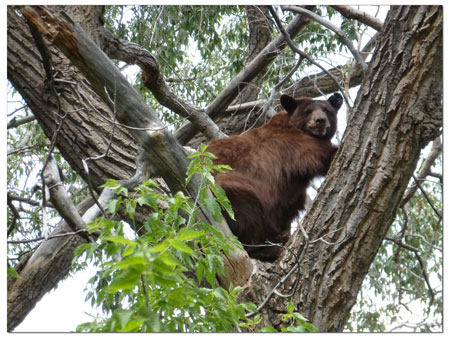 |
| A common sight this summer, a black bear hangs out mid-day in a tree along Junction Creek in August. So far this year, 1,024 bear sightings and incidents have been reported in La Plata County and over half of those have been in August./Courtesy Bear Smart Durango |
Close encounters
Current conditions ripe for human/bear conflicts
High five: 5 top tips for avoiding bear/human conflict
by Tracy Chamberlin
On an early August morning, Michael McCormack Sr. and his wife headed into town to run an errand. By the time they returned home a few hours later, they found their 55-gallon drum BBQ upended, the pile of firewood tossed about and the tomato plants in ruin.
On an early August morning, Michael McCormack Sr. and his wife headed into town to run an errand. By the time they returned home a few hours later, they found their 55-gallon drum BBQ upended, the pile of firewood tossed about and the tomato plants in ruin.
But it was the gaping hole in the side of their home that really left an impression.
A black bear had ripped open a hole about 5 feet high and 16 inches wide, according to McCormack, trying to gain access to the house. He said it looked as though the bear, estimated at 6 to 7 feet tall, started at a small gap from the dryer vent and tore through the redwood siding, sheeting, insulation and dry wall before being foiled by the dryer on the other side of the wall.
|
By the numbers: Bears in Trash |
“If the dryer had not been there, it would have gotten inside,” he added.
The McCormacks, who live off Highway 550 north of Durango Mountain Resort, have lived in the area for 35 years, but it’s only in the past 10 to 15 years that bears have become a common part of the landscape around their home.
So far this year, 1,024 bear sightings and incidents have been reported in La Plata County, according to data collected by Bear Smart Durango and the Colorado Parks and Wildlife Department, an increase of 20 percent over the 825 sightings reported in 2011.
And bear run-ins aren’t just happening north of town.
Last week, a Durango resident was blind-sided by a small bear while riding his bike. The two collided on El Paso Street and both appear to have survived, relatively unscathed.
Orion Olin, a waiter at Carver Brewing Co., suffered no fractures, broken bones or concussions. He said he thought the bear was the same cub he’s seen around his house the past couple of weeks.
It’s typical for bears to be out and about this time of year, trying to fatten up before their long winter’s nap. But more than half of the bear encounters and sightings in 2012 occurred in August. And, those are just the ones that have been reported.
Bryan Peterson, director of Bear Smart Durango, said the bears’ usual fare of berries and acorns suffered this year from a likely combination of a late May frost and drought conditions.
Pockets of good acorns exist, but overall natural food sources are in short supply, “so bears are scrambling,” he said.
When the food is hard to find in the wilderness, bears know just where to go for a high-calorie fix. Trash, pet food, ripe fruit from trees and bird feeders are some of the most common sources of easy meals for bears.
Colorado Parks and Wildlife recently sent out a press release reminding the public about bear activity in the fall, when the biological urge kicks in to fatten up for the winter. Bears need to have enough fat reserves to last a five- to six-month hibernation, according to Parks and Wildlife. They must increase their daily intake from about 8,000 to 20,000 calories, which equals 70 cheeseburgers a day.
For bears, it’s about the most energy gained for the least amount expended. “Research shows that bears look for and often return to sources of an easy meal,” according to the release.
With poor natural food sources and high-calorie human food available, the setting is ripe for an increase in human/bear encounters.
Parks and Wildlife stated in the release that the best way to prevent “serious conflict is to prevent (bears) from accessing trash and food in the first place, including pet foods and birdseed.”
They recommend removing outdoor bird feeders between spring and fall, securing trash, removing accessible food sources and not intentionally feeding bears. Peterson added using bear-resistant trash containers and electric fences, which are allowable in the county but not within city limits.
He also recommended removing ripe fruit from trees. Berries and acorns might have had a tough summer, but fruit trees have been exploding all over town.
Early warm weather and no late frost kept the blossoms alive and the produce plentiful in town. “It’s put fruit trees back on the menu of topics,” Peterson said.
Bear Smart Durango, along with other groups, has been exploring the idea of a coordinated, fruit gleaning program in the future.
According to Peterson, black bear populations nationwide are doing well and the “bad bear seasons seem to be coming closer and closer together,” creating more opportunities for human/bear encounters.
Parks and Wildlife agreed, stating in the release that research and studies indicate the black bear population is doing well in the state and will likely continue to flourish in the future.
“Unless climate change turns around,” Peterson said. “I don’t see things getting better around here.”
For more information visit bearsmartdurango.org or wildlife.state.co.us.
In this week's issue...
- May 15, 2025
- End of the trail
Despite tariff pause, Colorado bike company can’t hang on through supply chain chaos
- May 8, 2025
- Shared pain
Dismal trend highlights need to cut usage in Upper Basin, too
- April 24, 2025
- A tale of two bills
Nuclear gets all the hype, but optimizing infrastructure will have bigger impact
